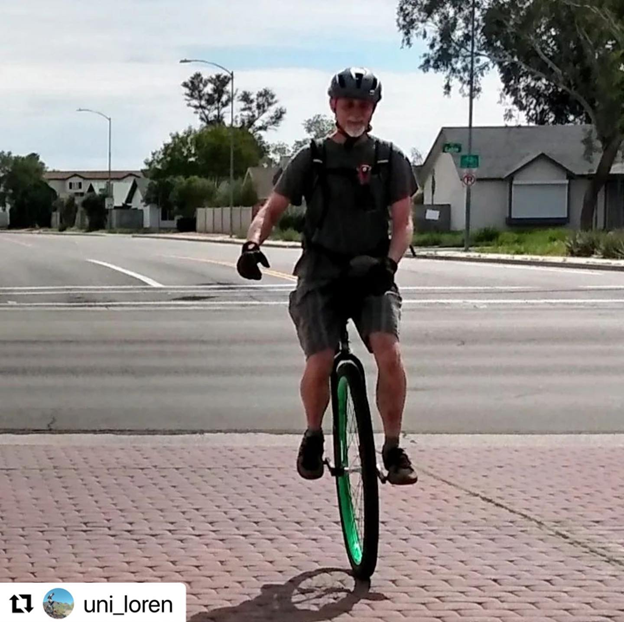The Delicate Interplay Between the Bike and Unicycle Industries
04/04/25
Considering the fact that unicycles are (sort of) bicycles with only one wheel, you might think that they shared a common evolution and plenty of common parts.
That assumption would not be entirely wrong. In fact it would be much more accurate than inaccurate.
But the truth is it hasn’t been a one-way street. The unicycle and bike industries have engaged in a delicate balance of give and take for the better part of 50 years, although the majority of the exchange likely occurred in the last 20. Here’s a quick breakdown of some of the more salient points.
The Evolution of Early Schwinn Unicycles and Bike Parts
Among the first unicycles that enjoyed wide commercial availability were Schwinn models. At one point we even sold Schwinn retro unicycles on this site - so this should come as no surprise.
That was back in the 1970s, when Schwinn basically ripped a whole lot off of existing bikes to get the job done. The first unicycles were basically the front fork of a bicycle, with a whole bunch of bike parts attached; the only two things that Schwinn had to adapt specifically were the unicycle hub and the saddle; everything else could more or less be adapted from either exercise bikes or street bicycles.
For obvious reasons Schwinn had to make a unique unicycle hub that would work with the frame/fork of the unicycle, along with the crank arms - but those parts, along with the pedals, hardware, and basically all other components were just recycled bike parts - down to the rim, spokes, and tire
The saddle was the other thing Schwinn had to figure out. What they landed on was a saddle with two “L” brackets that could be mounted to existing components.
Otherwise, they just used other bike parts (or exercise bike parts) to configure the whole thing, which in practice, exists today. Even now, many bike parts - such as pedals, cranks, tires, tubes, rims, spokes, seat tubes, and more - are still used in the construction of unicycles.
On that note, it’s all the same manufacturers that make these things for both unicycles and bikes, anyway.
That, at least, makes it obvious how the bike industry contributed to the rise of modern unicycles. After all, bikes came first, so it makes sense. What’s less obvious is how the unicycle industry then gave back to the bike industry - contributing to the rise and popularity of 32 inch tires (and to a separate degree, to 36 inch tires).
Unicycles Give Back: 32-Inch Tires

Fast forward a few decades, and we’re in the midst of the 2010s; at this point, the unicycle industry had come a long way and there were already mountain unicycles and street unicycles on the scene that were available with a fairly wide range of tire and crank arm sizes.
Many of the parts on unicycles at this point - roughly ten years ago - were still recycled bike parts. But it was about time for the unicycle’s adoption of something pivotal to make a big change in the bike world: first 36 inch, then inch tires.
A little bit earlier than this, someone solicited Unicycle.com and Coker Tire, which produced 36-inch tires for novelty penny farthing bikes. Recognizing that this would result in a faster ride, it was only a matter of time before Unicycle.com started getting requests for unicycles with 36-inch tires because at the time, 29-inch models were the fastest ones out there.
Unicyclists were quick to adopt the 36 inch tire not just because it was faster than the 29 and offered a smoother ride, but because it carried more rotational momentum. This meant not just that higher speeds were attainable, but that they could be sustained. The 36-inch offered better energy conservation for touring, racing, and commuting.
The 32-inch model is another story, but similar. Unicyclists were actually the first to develop the 32 inch tire as an alternative to both the 36 and 29. While not quite as fast as the 36, the 32 handles far, far better than its larger cousin.
We often make the analogy that a 36 inch unicycle handles like a dump truck; it might be fast, but it’s hard to get started, and just as hard to stop once you get it going. It’s also not agile at all. A model with a 32 inch tire handles a lot more like a model with a 29 inch tire, even though it’s significantly faster, by a few miles per hour at least.
So, while these two tire sizes haven’t completely taken over the world of bicycling, they’re gaining traction, and likely to continue to improve in popularity. Only time will tell, but for our part, we’ve returned the favor for the development of modern unicycles in the first place.
A Continuing Evolution
Whatever innovations will come out of either the unicycle or bicycle industry, and how they will be applied to each other, is anyone’s guess. But we are at and have been at the forefront in innovation in the unicycle industry and we are here for it!

